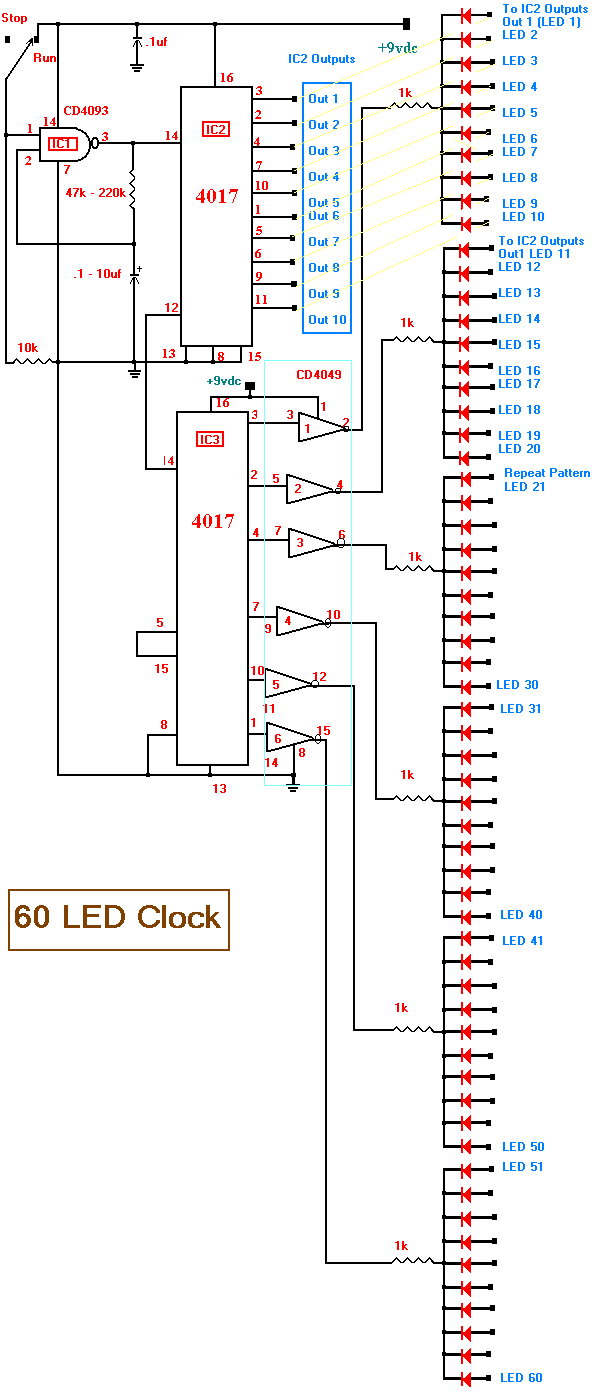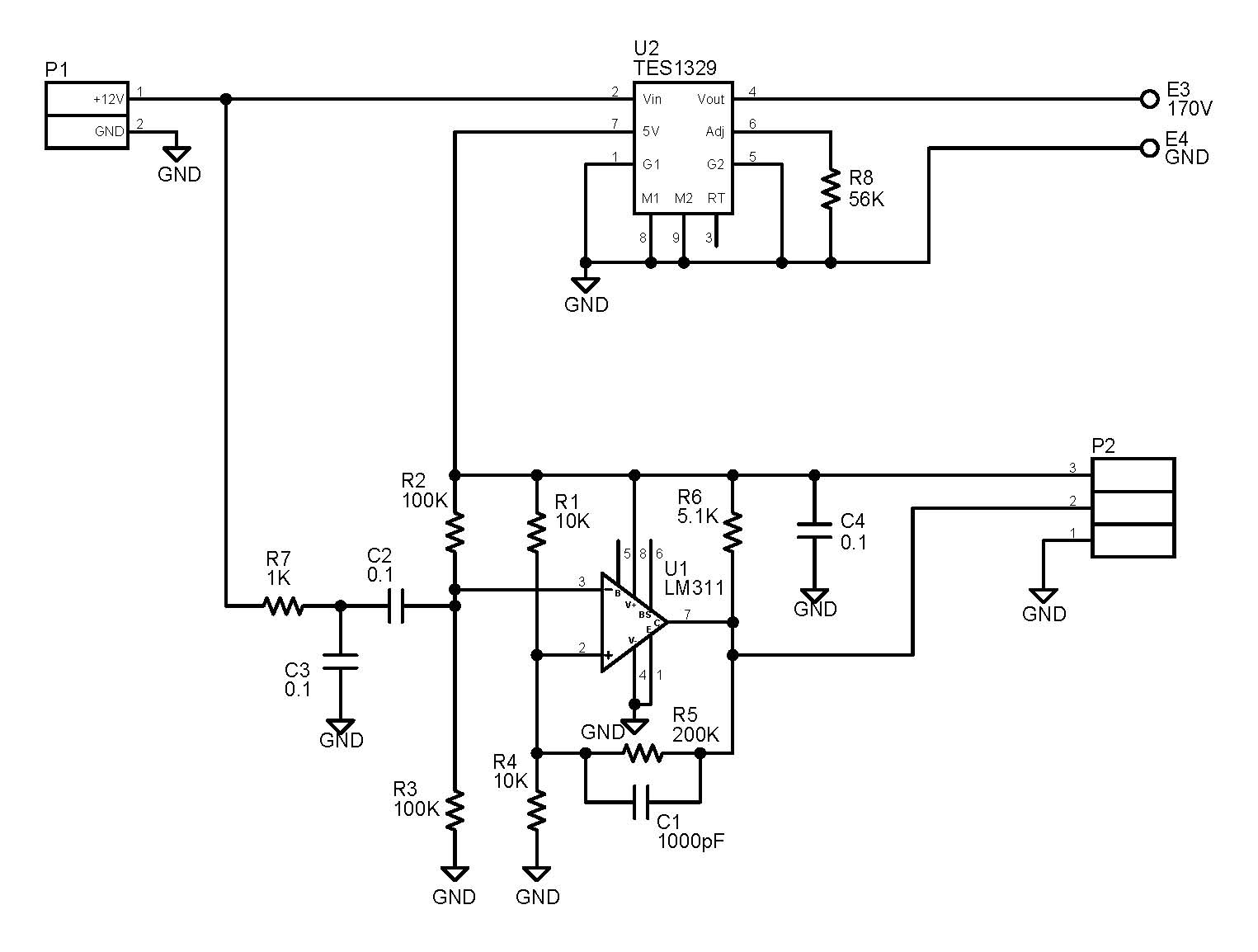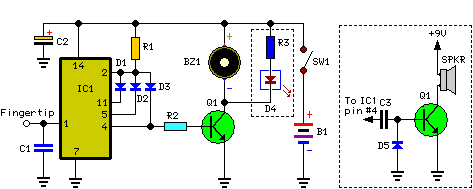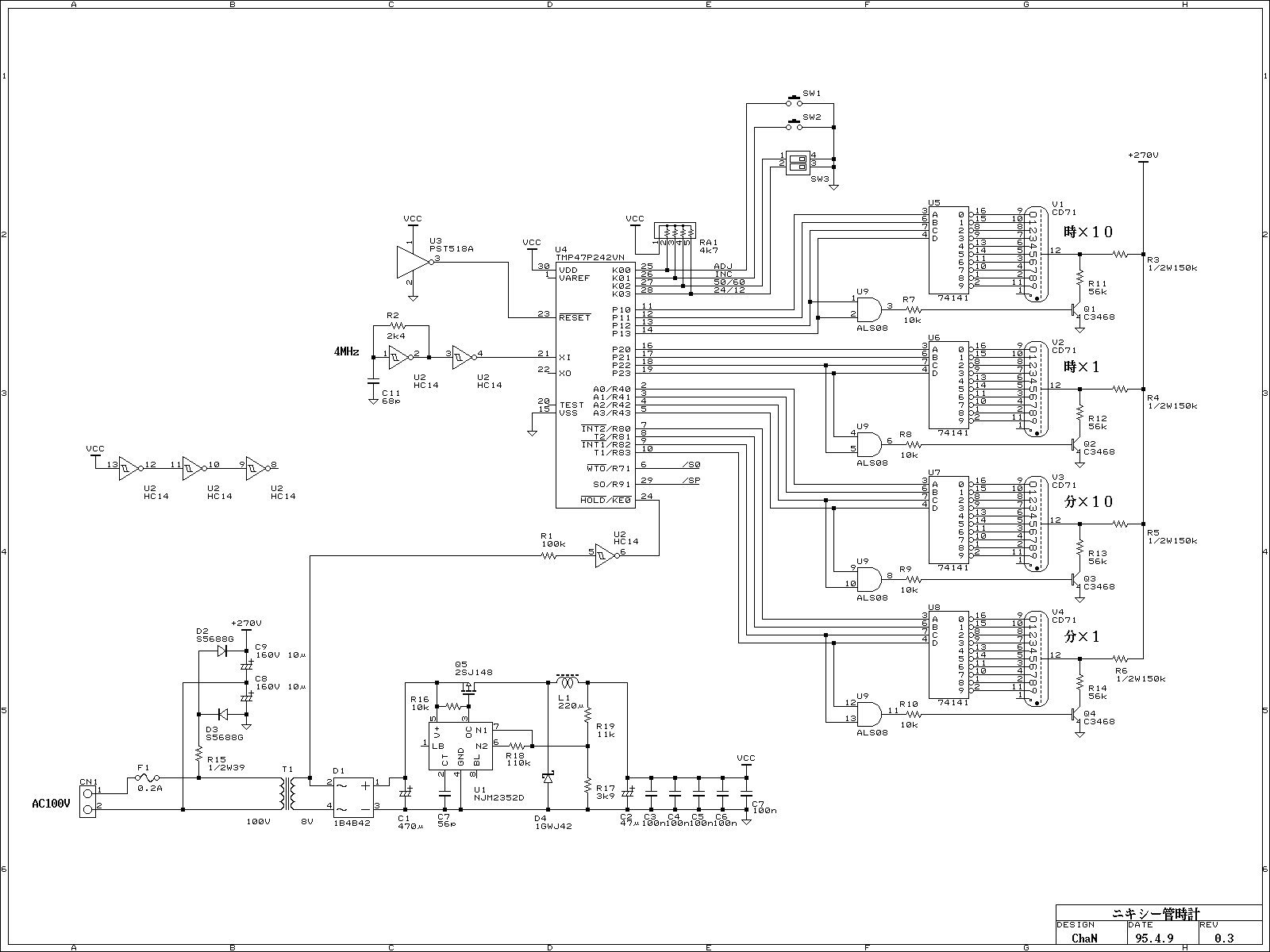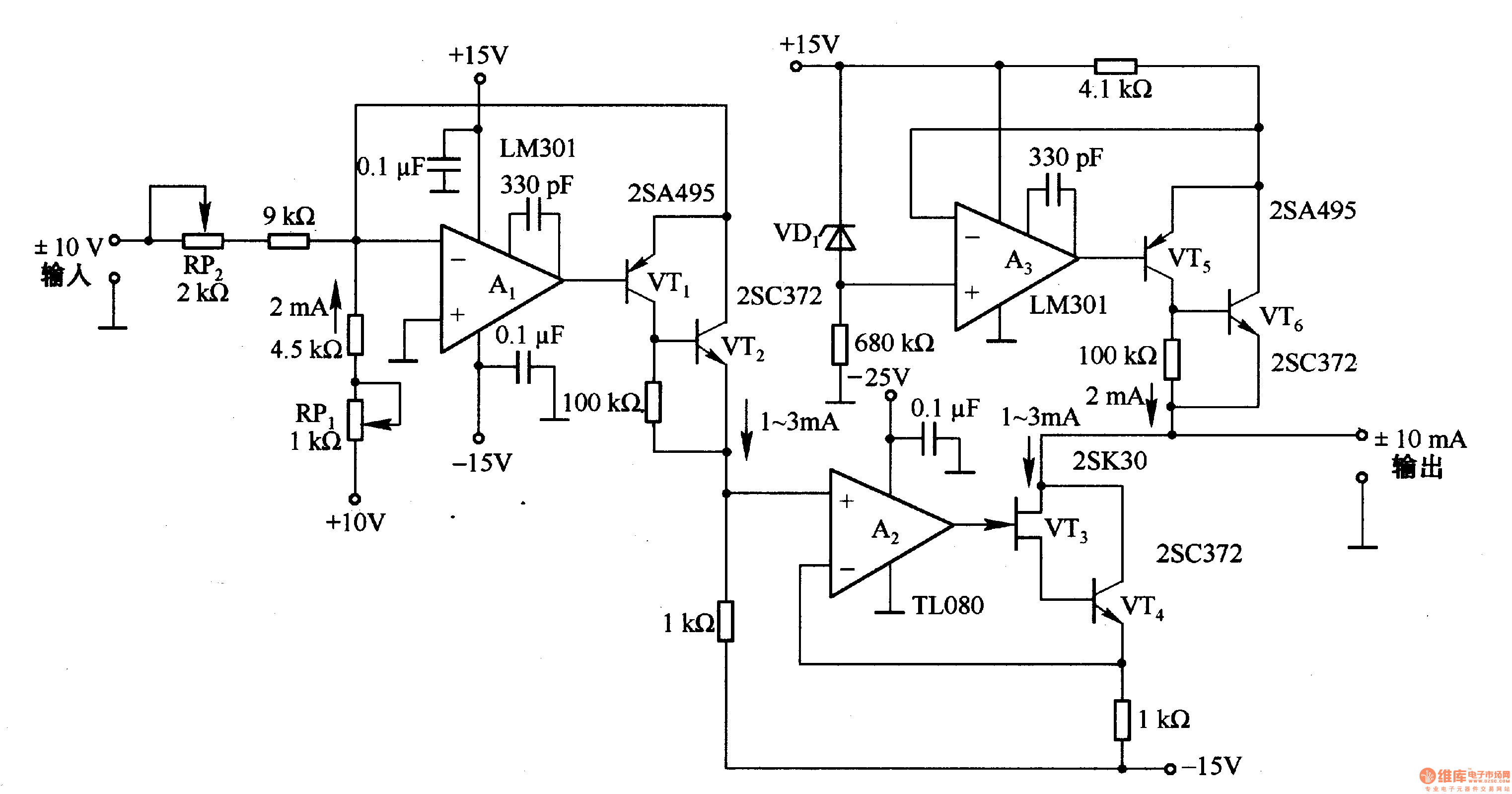
Nixie Clock Version 2
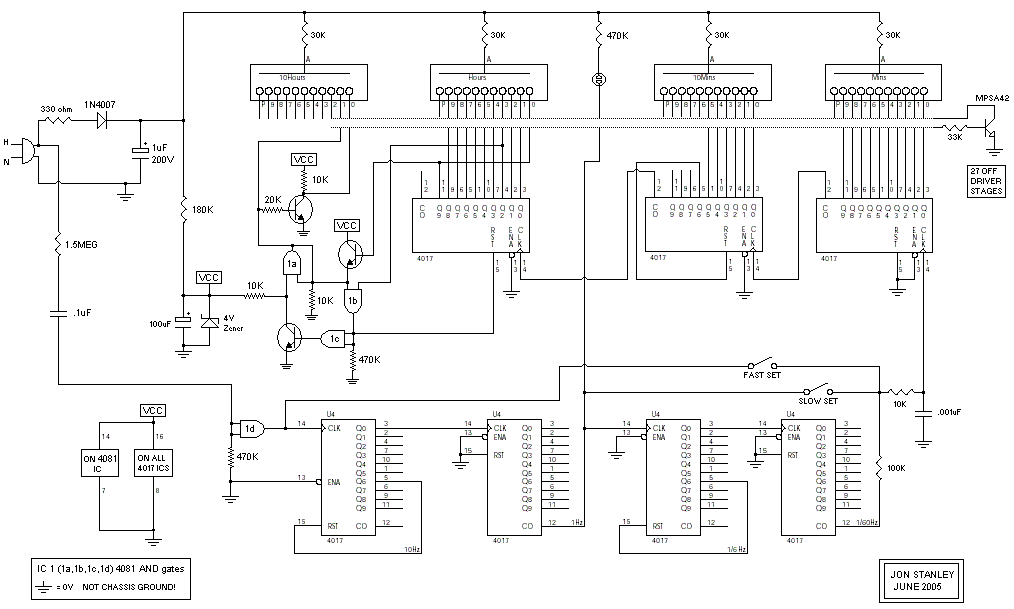
This is the new and improved nixie clock utilizing one of the smallest nixie tubes available, the Russian IN-17 nixies. The clock circuit is based on revisions of the version 1 nixie clock that were utilized in the Single Meter Clock. The logic circuits of this clock are essentially identical to those in the Single Meter Clock, with the exception that it features SLOW and FAST settings instead of hours and minutes. The only unique elements of this version 2 clock compared to version 1 are the inclusion of the 4081 quad 2-input AND chip, which replaces the 4013 flip-flop and the two 4017 counters. An AND gate is configured to function as a flip-flop for the ten hours, lighting up the "1" digit when set. A transistor NOT gate is employed for the "0" digit in the hours; when the AND gate is reset, the "0" is illuminated. When the AND gate is activated, the transistor operates to disconnect the Vcc from the high-voltage transistor, causing the "0" to turn off while the "1" is illuminated. Another AND gate is utilized to monitor the hour rollover to 13 (from 12:59) and reset the clock back to 1. The remaining AND gates serve as buffers, one for the 60Hz timing signal and another for the reset circuit. The use of the 4081 chip allowed for compact integration of all logic components on a 3 by 4 inch board. All integrated circuits are of DIP style, all resistors are rated at 1/4W, and the nixie drivers are implemented using traditional MPSA42 high-voltage transistors. The IN-17 nixies require approximately 130V to operate, negating the need for a voltage doubler from the 120V mains; instead, a simple half-wave DC power supply rectifies the 120VAC mains to about 170VDC, with a 1uF 200V capacitor used for filtering. This small filter capacitor serves dual purposes: it fits into the constrained space on the board and provides minimal DC filtering, resulting in slight flickering of the nixies. Consequently, the lifespan of the nixies is extended as they are not continuously illuminated. A small neon bulb is positioned between the two pairs of IN-17 nixies to function as a colon indicator.
The nixie clock design is characterized by its efficient use of space and components, making it suitable for compact applications. The 4081 quad 2-input AND chip plays a pivotal role in simplifying the logic design by reducing the number of discrete components required, thus enhancing reliability and minimizing potential points of failure. The configuration of the AND gates not only facilitates the counting mechanism but also ensures that the visual output is clear and distinct, with the use of transistors to control the high-voltage supply to the nixie tubes.
The choice of a half-wave rectifier circuit for powering the nixies is noteworthy, as it balances the need for high voltage with simplicity in design. The slight flickering effect, while unconventional, is a calculated decision aimed at prolonging the operational life of the nixie tubes, which are sensitive to prolonged high-voltage exposure. This design choice reflects a deep understanding of the operational characteristics of nixie tubes, optimizing their performance while also addressing longevity.
Overall, this nixie clock represents a blend of traditional technology with modern design principles, showcasing how classic components can be effectively integrated into a compact and functional timekeeping device. The addition of the colon indicator enhances the aesthetic appeal, making it not only a functional piece but also an attractive display item. This design can serve as a reference for further developments in nixie clock technology, particularly in the areas of compactness and energy efficiency.This is the new and improved nixie clock using one of the smallest nixies in the world, the Russian IN-17 nixies. The clock circuit is based on revisions of the version 1 nixie clock that were used in my Single Meter Clock.
The logic circuits of the clock is basically identical to the Single Meter Clock except it has SLOW and FAST set instead of h ours and minutes set. The only things that is unique to this version 2 clock compared to the version 1 is the 4081 quad 2-input AND chip, which eliminates the 4013 flip flop and the two 4017 counters. An AND gate is wired as a flip flop for the 10 hours, and when set, the "1" digit is lit. A transistor NOT gate is used for the "0" digit on the hours so when the AND gate is reset, the "0" is lit.
When the AND gate is set, the transistor is activated, which shuts off the Vcc from the HV transistor so the "0" turns off while the "1" comes on. The other AND gate was used to compare when the hours rolls over to 13 (from 12:59) to reset everything back to 1.
The remaining AND gates were used as buffers, one for the 60Hz line and another for the reset circuit. As a result of using the 4081 chip, I was able to stuff all of the logics and parts on a 3 by 4 inch board.
All the ICs were DIP style, all the resistors are rated 1/4W, and the nixie drivers were done the old-fashioned way with MPSA42 HV transistors. The IN-17 nixies only need roughly 130V to light up so it was not necessary to use a voltage doubler off the 120V mains; I used a simple half-wave DC power supply that rectifies the 120VAC mains to roughly 170VDC, and I used a 1uF 200V capacitor for the filtering.
The small size filter capacitor serves two purposes: so I could fit it on the packed space on the board and to provide less DC filtering so the nixies flicker slightly. As a result, the life of the nixies are longer because they are not lit continuously. A small neon bulb was inserted between the two pairs of IN-17 nixies as the colon indicator. 🔗 External reference
The nixie clock design is characterized by its efficient use of space and components, making it suitable for compact applications. The 4081 quad 2-input AND chip plays a pivotal role in simplifying the logic design by reducing the number of discrete components required, thus enhancing reliability and minimizing potential points of failure. The configuration of the AND gates not only facilitates the counting mechanism but also ensures that the visual output is clear and distinct, with the use of transistors to control the high-voltage supply to the nixie tubes.
The choice of a half-wave rectifier circuit for powering the nixies is noteworthy, as it balances the need for high voltage with simplicity in design. The slight flickering effect, while unconventional, is a calculated decision aimed at prolonging the operational life of the nixie tubes, which are sensitive to prolonged high-voltage exposure. This design choice reflects a deep understanding of the operational characteristics of nixie tubes, optimizing their performance while also addressing longevity.
Overall, this nixie clock represents a blend of traditional technology with modern design principles, showcasing how classic components can be effectively integrated into a compact and functional timekeeping device. The addition of the colon indicator enhances the aesthetic appeal, making it not only a functional piece but also an attractive display item. This design can serve as a reference for further developments in nixie clock technology, particularly in the areas of compactness and energy efficiency.This is the new and improved nixie clock using one of the smallest nixies in the world, the Russian IN-17 nixies. The clock circuit is based on revisions of the version 1 nixie clock that were used in my Single Meter Clock.
The logic circuits of the clock is basically identical to the Single Meter Clock except it has SLOW and FAST set instead of h ours and minutes set. The only things that is unique to this version 2 clock compared to the version 1 is the 4081 quad 2-input AND chip, which eliminates the 4013 flip flop and the two 4017 counters. An AND gate is wired as a flip flop for the 10 hours, and when set, the "1" digit is lit. A transistor NOT gate is used for the "0" digit on the hours so when the AND gate is reset, the "0" is lit.
When the AND gate is set, the transistor is activated, which shuts off the Vcc from the HV transistor so the "0" turns off while the "1" comes on. The other AND gate was used to compare when the hours rolls over to 13 (from 12:59) to reset everything back to 1.
The remaining AND gates were used as buffers, one for the 60Hz line and another for the reset circuit. As a result of using the 4081 chip, I was able to stuff all of the logics and parts on a 3 by 4 inch board.
All the ICs were DIP style, all the resistors are rated 1/4W, and the nixie drivers were done the old-fashioned way with MPSA42 HV transistors. The IN-17 nixies only need roughly 130V to light up so it was not necessary to use a voltage doubler off the 120V mains; I used a simple half-wave DC power supply that rectifies the 120VAC mains to roughly 170VDC, and I used a 1uF 200V capacitor for the filtering.
The small size filter capacitor serves two purposes: so I could fit it on the packed space on the board and to provide less DC filtering so the nixies flicker slightly. As a result, the life of the nixies are longer because they are not lit continuously. A small neon bulb was inserted between the two pairs of IN-17 nixies as the colon indicator. 🔗 External reference
